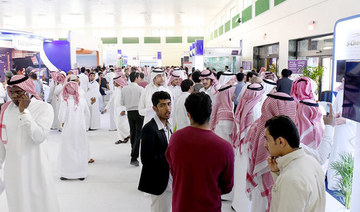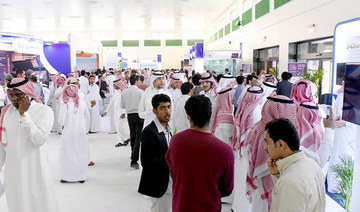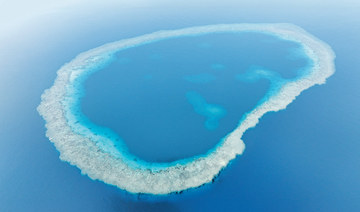RIYADH: Saudi Arabia’s biggest jobs fair for women on Tuesday opened in Riyadh offering thousands of career opportunities in the Kingdom’s booming labor market.
The three-day “A Step Ahead Career Fair,” organized by Saudi-based Glowork in cooperation with the Ministry of Labor and Social Development, will include 90 leading local and international companies showcasing employment options in a wide range of sectors.
In his welcoming speech Khalid Al-Saleh, managing director and founding partner at Glowork, said he hoped to see increasing numbers of women taking up the chance to work, and pointed to initiatives already in progress aimed at raising female participation in the Saudi jobs market from 22 percent to 30 percent by 2030.
Al-Saleh told Arab News: “We started it (the recruitment fair) seven years ago and organize it annually under the patronage of the Labor Ministry. It is a national-level event designed to empower Saudi women with all educational backgrounds and experiences.
“We invite the top 200 students selected from universities around the Kingdom to listen to experts from big organizations and learn from them to help make careers for themselves.
“We have had more than 190,000 women participating in events over the past six years, over 10,000 who got trained and attended free workshops, and around 36,000 women who have been hired through Glowork, many of them through this event,” added Al-Saleh.
He said graduates participating in the fair were also offered jobs by various companies, and many had gone on to reach senior management positions.
The career fair and recruitment conference include workshops designed to develop personal and soft skills for jobseekers.
Saudi Arabia’s biggest job fair for women opens in Riyadh
Saudi Arabia’s biggest job fair for women opens in Riyadh

- The career fair and recruitment conference include workshops designed to develop personal and soft skills for jobseekers
Saudi authorities arrest 21 Hajj permit violators

RIYADH: Authorities in Saudi Arabia have arrested 21 violators of Hajj regulations at the entrances to Makkah after they tried to enter without a valid Hajj permit, the state news agency SPA reported on Saturday.
The Ministry of the Interior announced that the Hajj Security Forces arrested eight residents and 13 citizens on Friday.
The seasonal administrative committees of the General Directorate of Passports issued 21 administrative decisions against them, which included: a prison sentence for a period of 15 days for each violator, and a fine of SR10,000 ($2,666).
The expatriate violators will then be deported and prevented from entering the Kingdom according to the legally specified periods after the execution of the sentence, while three vehicles used in their transportation have also been confiscated.
The Ministry of Interior called on all citizens and expatriates to abide by Hajj regulations and instructions so that pilgirms may enjoy safety, security, comfort and reassurance in performing their rituals.
Meanwhile, Lt. Gen. Mohammad bin Abdullah Al-Bassami, the director of Public Security and chairman of the Hajj Security Committee, stressed the security of the country, pilgrims, and the holy sites was “a red line.”
He said that safeguarding the pilgrims while they perform their Hajj rituals until they return to their home countries is a top priority for the Hajj security forces and that “preventing violators of Hajj regulations and those who have not obtained Hajj permits is central to this endeavor.”
He was speaking during a press conference held by the interior ministry for the commanders of the Hajj security forces in Makkah to brief on the ministry’s security, traffic, and organizational plans for this year’s Hajj season.
Al-Bassami said that the Public Security “has seized 140 fake Hajj campaigns and 64 carriers violating Hajj regulations, in addition to returning 97,664 violating vehicles and 171,587 non-residents of Makkah,” the SPA reported.
Authorities also apprehended 4,032 violators who did not have a valid Hajj permit and 6,105 violators of residency, work, and border security regulations, while those turned away in recent days from the holy city include 153,998 foreigners who held tourist visas rather than the required Hajj visas.
Did life on Earth originate in Red Sea waters off Saudi Arabia’s Sheybarah Island?

- Colony of living stromatolites discovered by KAUST team being hailed as a gift to geologists, biologists and environmental scientists
- Geology professor Volker Vahrenkamp had set out to take a closer look at a phenomenon they first spotted on satellite images
LONDON: It was something of an accidental discovery, admits Volker Vahrenkamp with a smile.
“Sometimes, these things need a little luck.”
Vahrenkamp, a professor of geology at King Abdullah University of Science and Technology in Thuwal, on Saudi Arabia’s Red Sea coast, had set out with a team of colleagues to take a closer look at a coastal geological phenomenon they had spotted on satellite images.
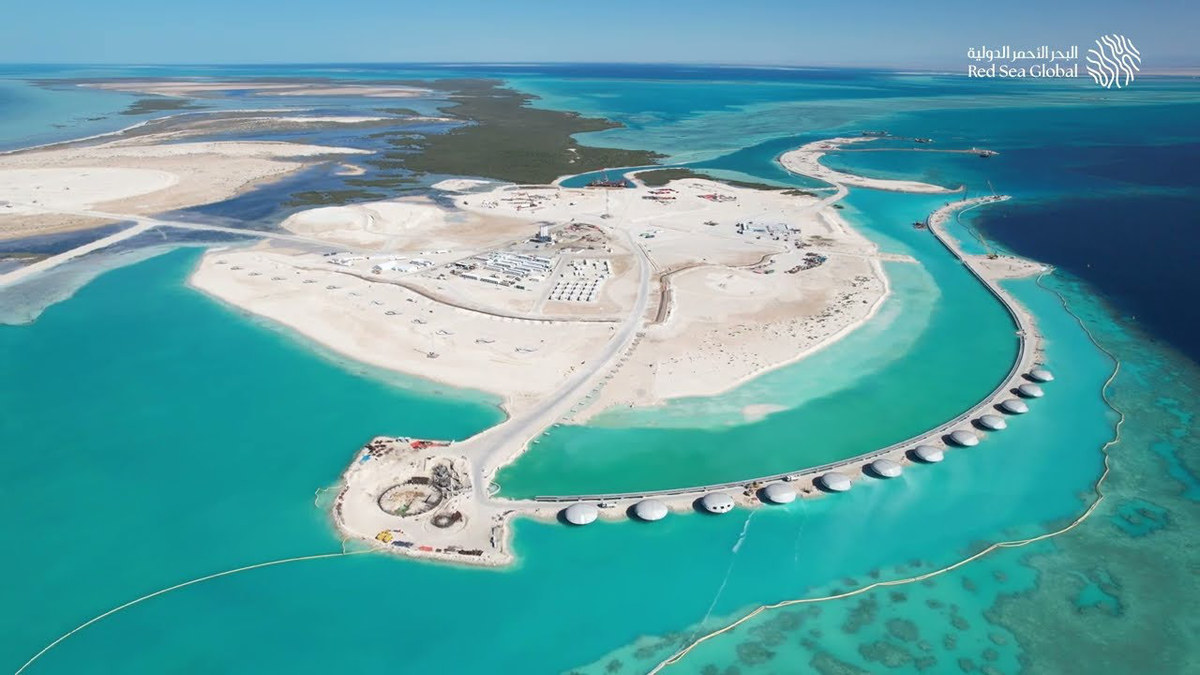
The so-called teepee structures, a tent-shaped buckling of sedimentary deposits found in intertidal zones, are valuable indicators of environmental changes, ancient and modern.
The team was delighted to discover there were examples virtually on their doorstep — just 400 kilometers up the coast from KAUST, off the southern tip of Sheybarah Island, best known for Red Sea Global’s luxury tourism resort of the same name.
“There aren’t really many good examples of teepee structures, where people can study how they form,” Vahrenkamp told Arab News.
“Then we spotted this, and it’s the most spectacular example that I’m aware of.”

The satellite images had shown that there were two teepee fields in the island’s intertidal zone and, after a short boat trip across from the mainland on a converted fishing boat, “we landed on the island, examined one field, and then started walking across to the other.”
And then, as they crossed the foreshore between the two, “we literally stepped on these stromatolites.”
Stromatolites are layered rock-like structures created by tiny microbes, individually invisible to the naked eye, some of which trap sediment in their filaments.
Living on rocks in the intertidal zone, they are covered and uncovered daily by the coming and going of the tides and, in a process known as biomineralization, slowly transform the dissolved minerals and sand grains they capture into a solid mass.
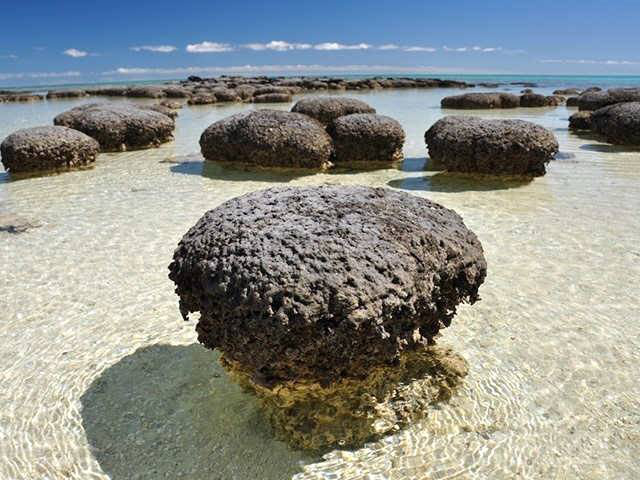
Human beings, and every other living thing on Earth that relies on oxygen to survive, owe their very existence to the tiny, so-called cyanobacteria that have been creating stromatolites for about 3.5 billion years.
Cyanobacteria were one of the first lifeforms on Earth, at a time when the planet’s atmosphere consisted mainly of carbon dioxide and methane. When they emerged about 3.5 billion years ago, they possessed a particular skill — the ability to generate energy from sunlight.
This process, photosynthesis, had a crucial by-product — oxygen. Scientists now believe that the microscopic cyanobacteria were responsible for the biggest thing that ever happened on the planet — the Great Oxidation Event, which saw Earth’s atmosphere transformed and set the scene for the evolution of oxygen-dependent life as we now know it.
Most stromatolites today are merely fossils. As other life on Earth developed, they lost their foothold in the planet’s oceans to competitors, such as coral reefs.

In a few places in the world, however, “modern” living stromatolites, “analogs for their ancient counterparts,” as Vahrenkamp puts it, continue to grow.
“Stromatolites are a vestige of the earliest life on Earth,” he said. “They ruled the Earth for an incredible period of time, about 3 billion years.
“Today they are part of the rock record in many parts of the world, but from these old rocks it is impossible to work out what type of microbes were involved and exactly how they did what they did.”
INNUMBERS
• 400 kilometers Distance of teepee fields from KAUST campus
• 3 billion Years when rock-like stromatolites ruled the Earth
• 120 Meters by which sea level was lower during last Ice Age
That’s why the discovery of a rare colony of living stromatolites, such as the one-off Sheybarah Island, is such a gift to geologists, biologists and environmental scientists.
“When you find a modern example such as this, the chances are that you might be able to better understand how the interaction of this microbial community led to the creation of stromatolites.”
Other examples are known, but they are almost always found in extreme environments, such as alkaline lakes and ultra-saline lagoons, where competitors cannot thrive.
One previous colony has been found in a more normal marine environment, in the Bahamas — which Vahrenkamp has visited, which is why he so readily recognized what he was walking on off Sheybarah Island — but this is the first example of living stromatolites discovered in Saudi waters.
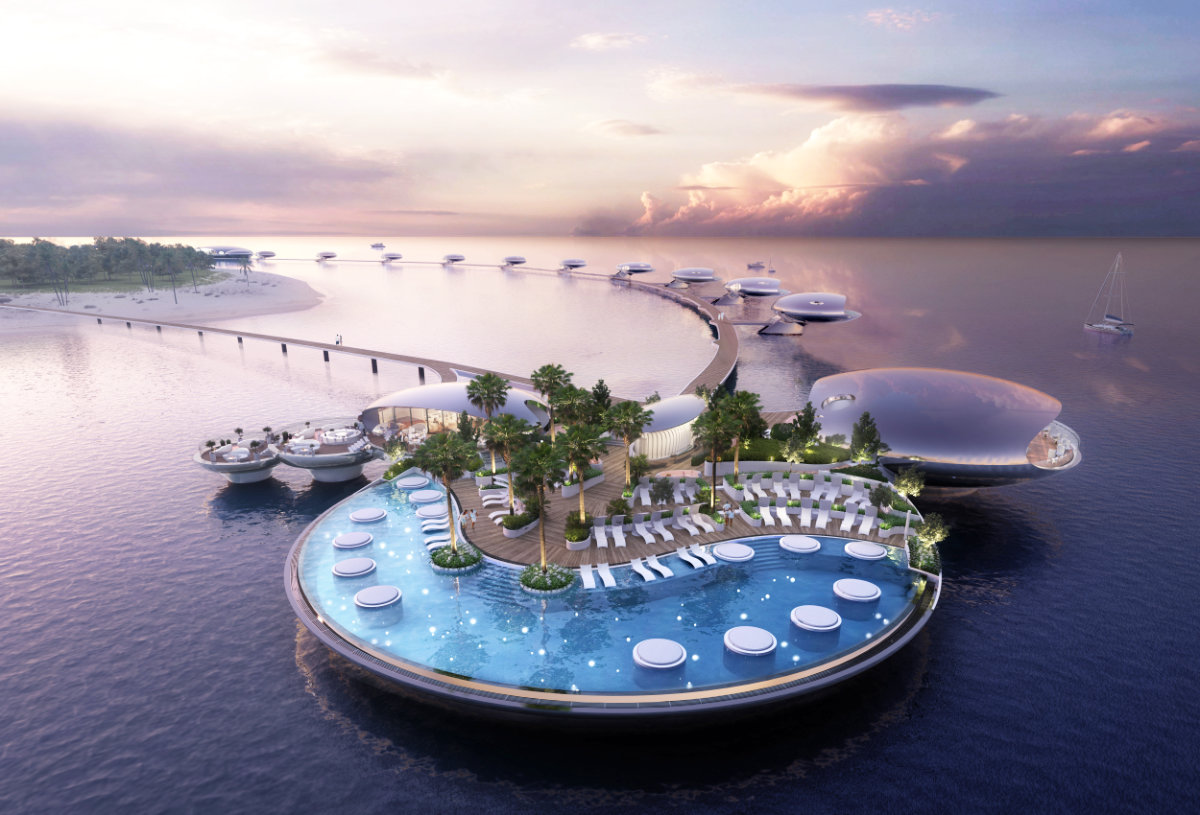
It is not yet clear how old these stromatolites are, “but we can bracket it a little,” said Vahrenkamp.
“We know that during the last Ice Age, the sea level here was 120 meters lower, so they were not there 20,000 years ago. The area where they are was flooded about 8,000 years ago to a height about 2 meters above where it is now, and then the sea level receded again to where it is now about 2,000 years ago.”
This does not mean the stromatolites are 2,000 years old. No one knows how long it takes the microbes to create their sedimentary layer cake and “no one has yet come up with a good way of dating the layers.
“The tide and the waves come along and throw in sand and material from the surrounding reefs and so all kinds of ages might be present. This makes it very difficult to precisely date the stromatolites and to estimate the growth rate.”
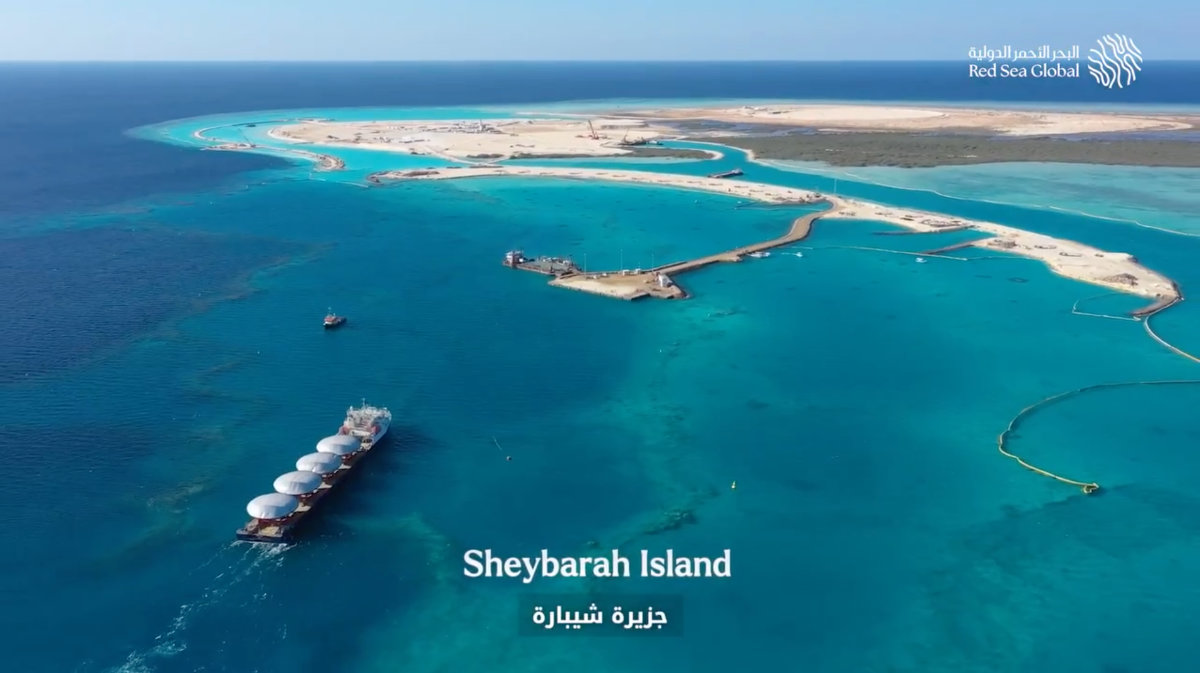
That is why Vahrenkamp and colleagues are now devising an experiment to recreate the natural environment of rising and falling tides and alternating sunlight and darkness in an aquarium, in an effort to grow stromatolites under controlled, easily observable conditions.
Whether this will take weeks or many years, “we honestly don’t know.”
The team is also working on genetically sequencing many of the thousands of different types of microbial bacteria at work in the stromatolite factory.
Opinion
This section contains relevant reference points, placed in (Opinion field)
“It’s a question of finding out ‘who’ is there, and who’s doing what,” said Vahrenkamp.
“But then there is also the question of what kind of functionalities do these bacteria have, and whether we can we use it in other ways, perhaps in medical applications.
“Scientists are now looking intently at the microbial composition of our guts, to find out which microbes cause cancer, for example, and which prevent it. The microbacteria at work in stromatolites could contain functional secrets that we simply are not yet aware of.”
The discovery also has resonance for the environmental ambitions of the Saudi Green Initiative, announced by Crown Prince Mohammed bin Salman in 2021 and which aims, together with the Middle East Green Initiative, to combat climate change through regional cooperation.
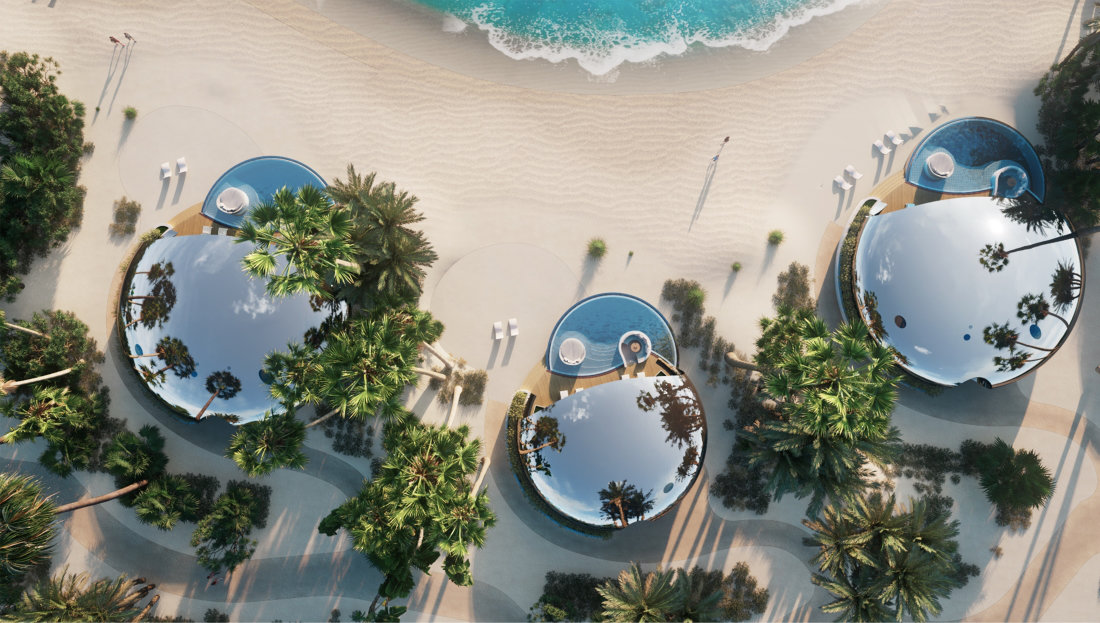
As Vahrenkamp and his seven co-authors wrote in a paper published recently in Geology, the journal of the Geological Society of America, “the discovery of the Sheybarah stromatolite fields holds important implications, not only in the scientific perspective, but also in terms of ecosystem services and environmental heritage awareness in line with the ongoing projects for sustainability and ecotourism development promoted by Saudi Arabia.”
In the paper, the KAUST scientists thank Red Sea Global for its support in accessing the stromatolite site, which is currently being considered for designation as a conservation zone.
As for the tourists relaxing in the spectacular new overwater villas on Sheybarah Island’s crystal-clear Al-Wajh Lagoon, an extra attraction now is that a short stroll along the beach will take them back in time for a glimpse of life on Earth 3.5 billion years ago.

Hajj pilgrims advised to take precautions against scorching heat

- Saudi government has implemented protective measures such as more areas for pilgrims to rest in
- Officials says unpredictable weather can affect health and safety of pilgrims, especially the elderly
RIYADH: Millions of Muslims from across the world have arrived to perform Hajj in Makkah during the hottest season of the year in the Kingdom, leading to concerns regarding the challenges that may await them in the days to come.
Unpredictable weather can affect the health and safety of pilgrims, especially the elderly. A primary concern is the extreme heat. As global temperatures continue to rise, heat waves in the region have become more frequent and intense every year.
Last year, temperatures in Makkah ranged between 43-45 degrees Celsius during Hajj, affecting the health of pilgrims, particularly the elderly, who are vulnerable to heat-related problems such as heat stroke and dehydration.
Ayman bin Salem Ghulam, CEO of the Saudi National Center for Meteorology, recently told a press conference in Makkah that maximum temperatures at the holy sites were expected to reach between 45-48 degrees Celsius in the afternoons.
Many elderly pilgrims have underlying medical conditions that can be triggered by heat, making them even more susceptible to health complications.
Dr. Fakhr Al-Ayoubi, president of the Cardio Clinical Pharmacy Group in Saudi Arabia, explained to Arab News how the rising temperatures impact the immune system and increase the risk of developing critical health conditions.

“Increased heat can lead to dehydration, heat stroke, and other heat-related illnesses, which can weaken the immune system and make individuals more susceptible to infections or illnesses,” she said. “It is therefore advisable for Hajj pilgrims to take appropriate precautions to stay hydrated, cool, and healthy during the pilgrimage, especially in the face of changing climate conditions.”
She also talked about the significance of vaccination prior to performing Hajj, not only to protect the health of the individual but also that of other pilgrims.
“Vaccines save lives, prevent diseases, and keep people safe. Sometimes it’s easy to forget this with how busy our lives get, but by ensuring that we stay safe as individuals through immunizations, we can all play a role in building a healthier, more productive community,” she explained.
Al-Ayoubi emphasized the importance of strengthening and safeguarding the immune system to protect pilgrims.

“If pilgrims become faced with weakened immune systems, that means that they are more vulnerable to catching diseases, and this creates a need to safeguard their health through vaccination,” she said. “This is especially important during Hajj, where it is commonly crowded, and people are in very close proximity to each other.”
The Saudi government and Hajj authorities have implemented a range of measures, including expanding medical facilities at various Hajj locations, providing more areas for pilgrims to rest in, and enhancing transportation and logistics to better accommodate the needs of pilgrims.
The imams and khatibs of the Two Holy Mosques have been directed to shorten Friday sermons and prayers during the Hajj season in consideration of the severe heat pilgrims are facing this year.
Sheikh Abdulrahman Al-Sudais, head of the Presidency of Religious Affairs at the Grand Mosque and the Prophet’s Mosque, said the directive aims to ensure the safety of worshippers in the mataf, roof, and courtyards of the mosques.
The decision is based on the Islamic principle of alleviating the difficulties of worshippers, such as those attending Friday prayers during the Hajj season.
Al-Sudais noted the importance of delivering concise and impactful messages during sermons. He had previously instructed imams to reduce the amount of recitation and the gap between the adhan and iqamah during the Hajj season to ease the burden on worshippers, particularly considering overcrowding and the presence of vulnerable and elderly people.
Hajj pilgrims advised to take precautions against scorching heat

- Government agencies have implemented protective measures such as more areas for pilgrims to rest in
RIYADH: Millions of Muslims from across the world have arrived to perform Hajj in Makkah during the hottest season of the year in the Kingdom, leading to concerns regarding the challenges that may await them in the days to come.
Unpredictable weather can affect the health and safety of pilgrims, especially the elderly. A primary concern is the extreme heat. As global temperatures continue to rise, heat waves in the region have become more frequent and intense every year.
Last year, temperatures in Makkah ranged between 43-45 degrees Celsius during Hajj, affecting the health of pilgrims, particularly the elderly, who are vulnerable to heat-related problems such as heat stroke and dehydration.
Ayman bin Salem Ghulam, CEO of the Saudi National Center for Meteorology, recently told a press conference in Makkah that maximum temperatures at the holy sites were expected to reach between 45-48 degrees Celsius in the afternoons.
Many elderly pilgrims have underlying medical conditions that can be triggered by heat, making them even more susceptible to health complications.
Dr. Fakhr Al-Ayoubi, president of the Cardio Clinical Pharmacy Group in Saudi Arabia, explained to Arab News how the rising temperatures impact the immune system and increase the risk of developing critical health conditions.

“Increased heat can lead to dehydration, heat stroke, and other heat-related illnesses, which can weaken the immune system and make individuals more susceptible to infections or illnesses,” she said. “It is therefore advisable for Hajj pilgrims to take appropriate precautions to stay hydrated, cool, and healthy during the pilgrimage, especially in the face of changing climate conditions.”
She also talked about the significance of vaccination prior to performing Hajj, not only to protect the health of the individual but also that of other pilgrims.
“Vaccines save lives, prevent diseases, and keep people safe. Sometimes it’s easy to forget this with how busy our lives get, but by ensuring that we stay safe as individuals through immunizations, we can all play a role in building a healthier, more productive community,” she explained.
Al-Ayoubi emphasized the importance of strengthening and safeguarding the immune system to protect pilgrims.

“If pilgrims become faced with weakened immune systems, that means that they are more vulnerable to catching diseases, and this creates a need to safeguard their health through vaccination,” she said. “This is especially important during Hajj, where it is commonly crowded, and people are in very close proximity to each other.”
The Saudi government and Hajj authorities have implemented a range of measures, including expanding medical facilities at various Hajj locations, providing more areas for pilgrims to rest in, and enhancing transportation and logistics to better accommodate the needs of pilgrims.
The imams and khatibs of the Two Holy Mosques have been directed to shorten Friday sermons and prayers during the Hajj season in consideration of the severe heat pilgrims are facing this year.
Sheikh Abdulrahman Al-Sudais, head of the Presidency of Religious Affairs at the Grand Mosque and the Prophet’s Mosque, said the directive aims to ensure the safety of worshippers in the mataf, roof, and courtyards of the mosques.
The decision is based on the Islamic principle of alleviating the difficulties of worshippers, such as those attending Friday prayers during the Hajj season.
Al-Sudais noted the importance of delivering concise and impactful messages during sermons. He had previously instructed imams to reduce the amount of recitation and the gap between the adhan and iqamah during the Hajj season to ease the burden on worshippers, particularly considering overcrowding and the presence of vulnerable and elderly people.
Saudi HR ministry promotes seasonal work during Hajj

- About 43,000 work permits issued across various fields
RIYADH: The Saudi Ministry of Human Resources and Social Development is continuing its Ajeer Al-Hajj and Seasonal Permits services as part of efforts to encourage seasonal work during this Hajj season, the Saudi Press Agency reported on Saturday.
The Ajeer Al-Hajj service allows facilities to issue work permits, and employ Saudis and residents temporarily. It also enables them to post job openings during the Hajj season through the Bab Ajeer platform, in addition to allowing job seekers to review and apply for work.
Ajeer Al-Hajj has several goals, including enhancing workforce flexibility and increasing its competency in the market, providing flexible solutions, and reducing dependence on outside labor.
The service is easily available electronically for facilities and individuals through the platform’s website. A total of 924 facilities benefited from the service, with 11,715 permits issued, SPA reported.
The seasonal permits service allows facilities working during the Hajj season to cover the number of workers needed and contributes to serving pilgrims, as the ministry had earlier worked on issuing seasonal permits to facilities under facilitated and easy terms.
The number of seasonal work permits issued reached 42,853 for several professions in different fields, SPA said.
The ministry’s oversight committees carry out follow-ups to ensure that facilities operating during the Hajj season abide by the requirements and terms of the seasonal work permit regulations.
They also ensure that facilities comply with the regulations and instructions.
The ministry carried out several field visits to oversee facilities and follow up on the work system provisions and regulations in Makkah and the holy sites.





